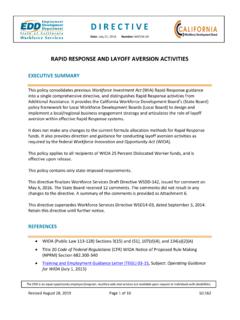Transcription of Fatigue risk management - Queensland Health
1 Human Resources Policy Fatigue risk management Policy Number: I1 (QH-POL-171). Publication date: december 2014. Purpose: To ensure workplace Fatigue is managed so as to minimise its effects and related risks on the workplace, employees, patients and others through the application of a best practice risk management framework as core business function. Application: This policy applies to employees working for the Department of Health and non-prescribed Hospital and Health Services Delegation: The delegate' is as listed in the Department of Health Human Resource (HR). Delegations Manual and the Hospital and Health Services Human Resource (HR) Delegations Manual HRM Functions of the Director-General, as amended from time to time.
2 Legislative or other authority: Work Health and Safety Act 2011. Related policy or documents: Medical Officers' ( Queensland Health ) Certified Agreement ( ) 2012 (MOCA3). Health Practitioners ( Queensland Health ) Certified Agreement (No. 2) 2011. Nurses and Midwives ( Queensland Health ) Certified Agreement (EB8) 2012. Risk management Policy (QH-POL-070:2013). Work Health and Safety Policy (QH-POL-401:2014). Work Health and Safety management System Patient Safety Health Service Directive (QH-HSD-032:2013). Fatigue Risk management e-learning program (link: ). Fatigue Risk management Resource Pack (link: ). Policy subject: 1 Policy statement.
3 2. Principles for managing Fatigue ..2. Definitions: .. 2. History: .. 3. Schedule One Responsibilities Fatigue risk management Schedule Two Defences in Depth diagram Please note that any material printed is regarded as an uncontrolled copy. It is the responsibility of the person printing the document to refer frequently to the Queensland Health Internet site for updates. HR Policy I1. december 2014. 1 Policy statement This policy aims to establish a proactive approach to the management of Fatigue and related risks and demonstrates a commitment to ensuring safe systems of work and providing an environment that is safe for employees, patients and the public by reducing Fatigue to as low as reasonably practicable.
4 Additional information on management Fatigue is available in the Fatigue risk management resource pack. Principles for managing Fatigue The following principles apply: Fatigue -related risk shall be managed by a shared approach between the employer and employees, with each party discharging their duty to address matters that fall within their responsibility and accountability (refer to Schedule One). Fatigue risk management shall be based on a sound risk management approach using the Defences in Depth Model' (refer to Schedule Two), where risks are identified, assessed, controlled and reviewed on a regular basis. The Fatigue risk management system (FRMS).
5 Implemented shall recognise the complexity of services provided and acknowledge that increased Fatigue levels may be unavoidable. A systematic approach to management of Fatigue and Fatigue related risk shall be incorporated into HHSs'/divisions'/agencies' core business operations and shall incorporate fundamental risk management principles. The FRMS shall incorporate training that: enhances employees' ability to recognise signs of Fatigue in themselves and others, and actions that can be taken to manage their own Fatigue outlines the obligations of all parties to manage workplace Fatigue provides an awareness of this policy and the resources available to help meet the policy's purpose.
6 The FRMS shall be integrated with existing work Health and safety management systems (WHSMS) to achieve consistency and to demonstrate compliance with legislated work Health and safety requirements. Definitions: Term Definition Fatigue Fatigue is defined as a decreased capacity to perform mental or physical work, or the subjective state in which one can no longer perform a task. Fatigue manifests in physiological performance decrements and cognitive impairment. Fatigue primarily arises as a result of inadequate restorative sleep, but is also influenced by time of day and how long an individual has been awake. Fatigue risk An integrated set of beliefs, management practices, and procedures management system for monitoring and managing the risks posed to Health and safety by (FRMS) Fatigue .
7 Fatigue risk management Page 2 of 3. Please note that any material printed is regarded as an uncontrolled copy. It is the responsibility of the person printing the document to refer frequently to the Queensland Health Internet site for updates. HR Policy I1. december 2014. History: december 2014 Policy amended to update hyperlinks for training and resource pack June 2014 Policy formatted as part of the HR Policy Simplification project. Policy amended to: update references and naming conventions integrate content of Medical Fatigue Risk management HR Policy I1. and Health Practitioner Fatigue Risk management Policy (QH-POL- 358).
8 April 2012 Health Practitioner Fatigue Risk management Policy and Implementation Standard for Health Practitioner Fatigue Risk management released January 2011 Medical Fatigue Risk management Policy QH-POL-171:2011. supersedes Medical Fatigue Risk management Human Resources Policy (I1) and Interim Queensland Health Continuous/ Cumulative Hours Procedure Medical Officers Medical Fatigue Risk management Implementation Standard released May 2010 Revised to ensure consistency with the terminology used in Queensland Health 's Integrated Risk management Framework. January 2009 Revised to reflect the Queensland Health structural reform of August 2008.
9 August 2008 Developed as per clause Fatigue Policy Statement' Medical Officers ( Queensland Health ) Certified Agreement ( ) 2005. Endorsed by the Executive management Team. Previous Interim Queensland Health Continuous/Cumulative Hours Procedure . Medical Officers Fatigue risk management Page 3 of 3. Please note that any material printed is regarded as an uncontrolled copy. It is the responsibility of the person printing the document to refer frequently to the Queensland Health Internet site for updates. SCHEDULE ONE - HR Policy I1. december 2014. Fatigue risk management - Schedule One Responsibilities Position Responsibility Audit criteria Director-General Provide leadership and stewardship for Regularly review the Fatigue risk management in Queensland FRMS.
10 Health . Encourage a just safety culture to manage Fatigue -related risk. Fatigue risk management is considered in strategic planning and executive decision making. Support prioritising allocation of available resources to reduce very high and high risk Fatigue to as low as reasonably practicable. (Delegated to Deputy Director- General, System Support Services Division). Support the inclusion of Fatigue risk management in performance monitoring criteria. Advise government of barriers preventing the reduction of very high or high risks to an acceptable level. The Director-General is supported by the roles and positions below to ensure that Fatigue related risk is managed through the implementation of a Fatigue risk management system.











